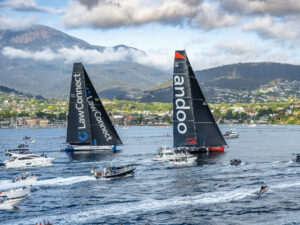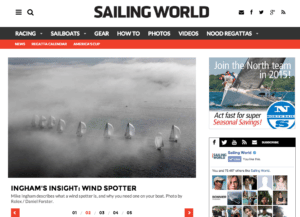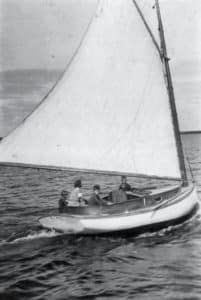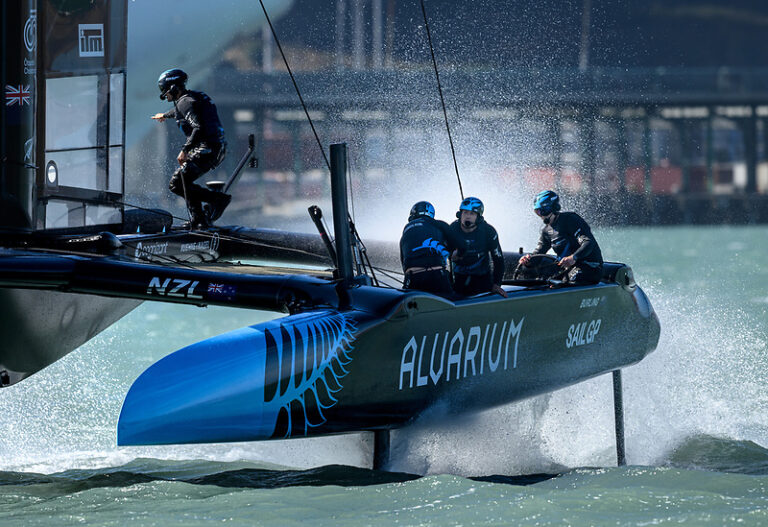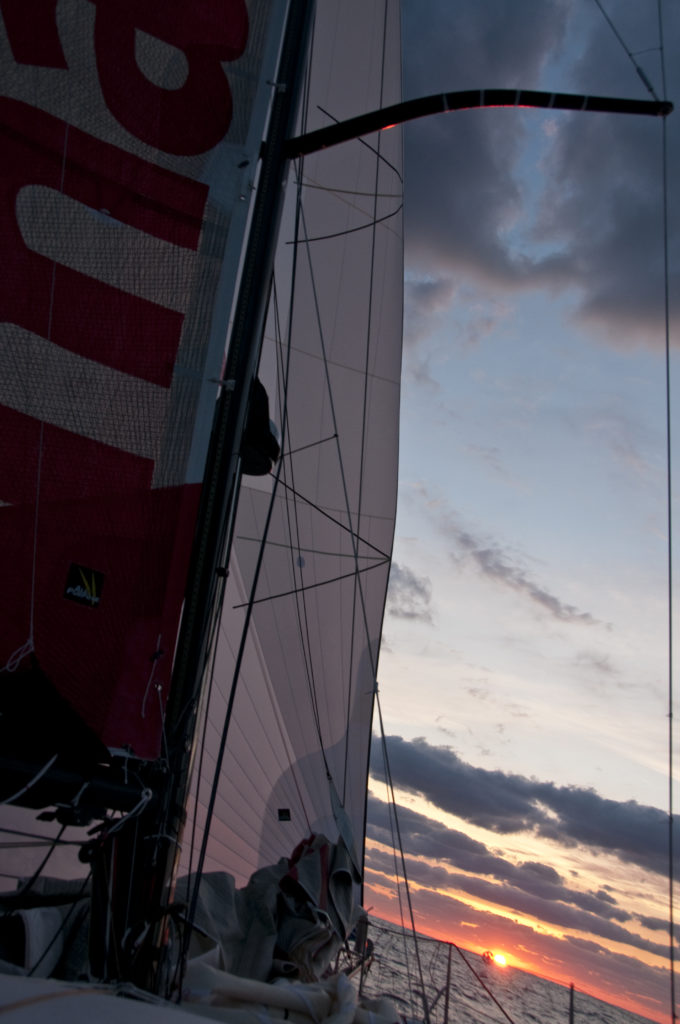
Atlantic Cup Day 1
Sailing World’s_ roving big-boat correspondent Ryan O’Grady sailed in Leg 1 of the Atlantic Cup as the media crew member onboard Jörg Reicher’s Class 40 Mare with co-skipper Ryan Braymaier._
Why is it that the hardest parts of any race are getting off and back on the dock? Four p.m. was dock call, and with German efficiency the motor was on and running right on time. The only problem was that no one checked to see if the engine was able to go into gear before we untied from the dock. In a place as tidal as Charleston, this was a recipe for disaster. With impending disaster looming, my first media man crisis was whether to help to avert disaster, or stand by with the camera running? Since it was pre-race, and I was being asked rather firmly to pitch in, the camera was left off as we tried to raise the main and keep from running aground in the narrow channel by the Charleston Marine Center. Once the sails were up, my time as a sailor officially ended, and it was into cameraman mode for the next three days.
Compared to more traditional 40 footers, the Class 40 is amazingly roomy down below. With a wide beam, high form stability, and a deck stepped mast, the interior feels like a big bright room. There are even have windows for light, and, as opposed to the current crop of jet back carbon hulls, the fiberglass hull of Mare is translucent enough to see the water rushing by its side. Yet with all that space, I’m was always in the way: Couldn’t use the pipe berth, that’s for the sleeping crew. Couldn’t sit at the little molded seat that forms the nav station either, since the weather GRIB files always seem to arrive 10 minutes after I start downloading video. The cockpit is small and lined by high comings for crew safety, so I always seemed to be in the way there too. I couldn’t even sit on deck at the start, since the camera people wanted to see doublehanded sailors, not a media guy. Finally after a bit of searching, I found my “office” in the aft stacking bay on the weather side. There was a great view out of the transom safety hatch to judge speed. For the next few days I slept, edited video, and wrote from this cocoon, at least until I found myself in the way there too. Maybe it’s easier on a Volvo 70, there’s more space in which to hide and more people to blend in with.
The other big challenge being a media man was finding stuff. Every other time I’ve gone offshore, I’ve known the boat and the crew well. For the Atlantic Cup, however we only had a few quick hours to chat prior to the event. Every small daily life event now requires a question. “Where’s the water?” “How do I use the turbo heater without blowing up the boat?” Last but certainly not least, “Bucket, bag, or transom?”
With all of this personal drama, it’s amazing there was actually time for a sailboat race! Our prestart plan was to start at the pin, lead the fleet to the turning mark, extend in the tacking duel out of the two-mile jetty, and then sail as fast as possible due east to find the Gulf Stream. The only problem was that we were about 30 seconds late to the start and forced to play catch up right from the start. As bad as out day was, it was about to be worse for Hannah Jenner and Peter Harding on 40 Degrees. Just past the first turning mark, 40 Degrees was just to leeward of us when the always gut wrenching sound of cracking carbon fiber was heard across the harbor. Their mast had failed just above the first spreader, and the Atlantic Cup was down to 14 teams. On Mare, we were about 12th. Maybe we could tack our way to a better position, since we’d need to do it about 10 times before reaching the open ocean.
Tacking out of the jetty was interesting to say the least. In the skipper’s meeting the day before the start we were promised that there would be no commercial shipping in the harbor during the start time. That statement proved to be no good as no less than five ships were transiting as we were starting. It can be a real sickening feeling having an 800-foot container ship bearing down on you when you are short tacking between stone walls and shallows. We even managed to bump aground once avoiding a ship. Through all that insanity, we did manage to pass some boats and were someplace around sixth when we could finally put an end to the tacking. If only we could have put away going to windward as well.
The fastest way to make it to the Gulf Stream while still making sensible VMG to New York was to aim for a place off the North Carolina coast called Frying Pan Shoals. To get there, we were looking at nearly 12 hours of starboard tack beat in a dying northeasterly breeze. Onboard Mare, Ryan, Jörg, and I were learning how to get along together. With the accrued skill of a world circumnavigator, Ryan is the model of nonchalance. Nothing is a problem to him as long as we stick to our plan and execute it. That means sailing in full upwind mode, even as teams around us our starting to crack sheets and go faster. “Our goal is to be outside everyone and first to the stream. The French don’t know how to sail upwind; they just love cracking off a bit to feel good. Don’t follow them.” This was Ryan’s constant mantra. Jörg, however, can’t sit still. He was constantly fidgeting with every part of the boat. One second he was moving the stack, the next second he was dashing about the cockpit making small sail adjustments, then he’s off to add water ballast. It was quickly clear that he’s obsessed with boatspeed, while Ryan’s job was to manage the bigger strategic picture.
Day quickly became night, and I was once again reminded of the true beauty of a starry night sky. On the horizon behind us, mast top lights went from red to green as Mare continued to fight for upwind height. Through smart boatspeed and tactics, we had worked ourselves up to second behind Campange de France and just ahead of rival Talan Bureau Veritas. We were just ahead and to leeward of Talan when she decided to abandon her upwind strategy and begin to sail to shore. Putting the boat under autopilot, the crew soon deployed their code zero. In the process, they came tearing down on us, nearly causing a collision. We were confident in our decision to continue to the Gulf Stream, and the race for first was on.
Dawn and Frying Pan Shoals lighthouse greeted us together on Saturday morning. Here, we could first start the effect of the Gulf Stream pulling us north, but the major current push was still further offshore. The major tactical decision of the day would be whether to bear off and set a code zero. By doing so, we would sail less distance to New York, but we would have to wait a bit longer to hit the Gulf Stream proper. Since we had worked hard to position ourselves as the most offshore boat, we waited for Campange to bear away, then played the growing clouds near the Gulf Stream for local breeze advantage. Finally at about midday, we finally put the bow down towards New York, and Ryan and Jörg busied themselves with hoisting the code zero.
Changing sails on a doublehanded boat isn’t a simple, or quick, procedure. Getting everything assembled for the code zero hoist takes nearly 10 minutes, so you need to make sure the sail call is correct, and won’t be reversed in 10 minutes. By the time our zero was up and flying, we saw a boat come over the horizon, much further offshore than us. Bodacious Dream had followed our plan, but they took it all the way to the Stream, while we had elected to cut the corner. Putting the zero away, tacking, and going to cover Dream was discussed, but in the end viewed as too costly. For the rest of day one and part of Day 2, we’d watch our competitors roll us and pass on over the horizon.

